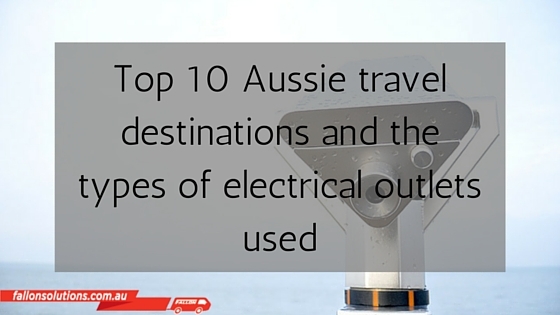14 June 2016
Top 10 Aussie travel destinations and the electrical outlets used
Modern travellers carry with them more electronic gadgets than ever before. Even the most basic packing list will include a mobile phone and laptop or tablet. Quite often travel luggage will also contain many other electrical items such as hairdryers, electric toothbrushes, electric razors, hair straighteners, curlers and so on.
Being able to plug in your electrical equipment when you arrive takes some planning, especially if you are travelling through a few different countries. We have put together a quick list of the socket types used in the ten most popular travel destinations for Aussie travellers so you’ll know which adapter to pack.
According to the Australian Bureau of Statistics the most travelled to countries by Australians in 2015 were:
- New Zealand
- Indonesia
- USA
- UK
- Thailand
- China
- Singapore
- Fiji
- Japan
- India
Make sure you check whether the voltage of your electrical appliance is suitable for the voltage used in the country you are visiting. In some countries, this can vary within the country as well. Always check with your destination to avoid damaging your appliance or risk causing a fire.
New Zealand
You’re in luck, New Zealand uses the same 240 V system with a type I 3 flat pin power plug as Australia, so there is no need to get an adaptor when travelling in NZ. Frequency – 50 Hz

Indonesia
Indonesia, including Bali, uses a Type C, 2 round pin socket and plug design, 230 V standard. Frequency – 50 Hz

USA
The United States of America uses two types of socket styles, type A and B, with a standard voltage of 120 V. As the voltage is much lower than our standard 220 to 240V you will need to invest in a power converter or transformer. Frequency – 60 Hz*


UK – England, Scotland, Wales and Northern Island
In the United Kingdom, the standard voltage is 230 V with a type G socket and plug, with three large rectangular pins. Frequency – 50 Hz

Thailand
Thailand uses several socket styles with a 220 V standard. Socket types A, B, C and O are used around the country, check with your specific destination as to the best adaptor to purchase. Frequency – 50 Hz




China
Power sockets type A, C and I are used in China with a standard voltage of 220 V. Frequency – 50 Hz



Singapore
A 230 V standard voltage and power socket type G (the same used in the UK) are used in Singapore. Frequency – 50 Hz

Fiji
Fiji uses a 240 volt system with type I sockets and plugs, the same as the Australian standard. Frequency – 50 Hz

Japan
A lower voltage standard of 100 V is used throughout Japan with two styles of power sockets, type A and B. Frequency – 50/60 Hz*


India
India utilises three styles of power sockets C, D and M with a standard voltage of 230 V. Frequency – 50 Hz



* Please note – the difference between the 60 Hz frequency and the standard Australian 50 Hz can cause timing devices like electric clocks to operate slightly faster which can cause them to keep the incorrect time.
References
- Images – http://www.worldstandards.eu/electricity/plugs-and-sockets/
- http://www.power-plugs-sockets.com/united-states-of-america/
Related electrical posts
Suggested articles
No articles found

